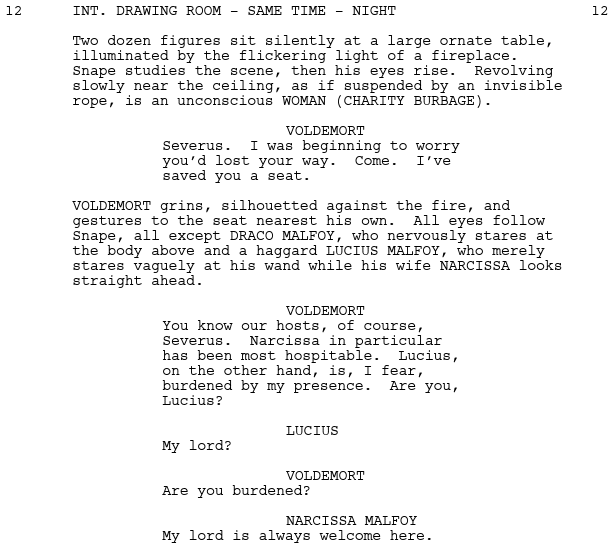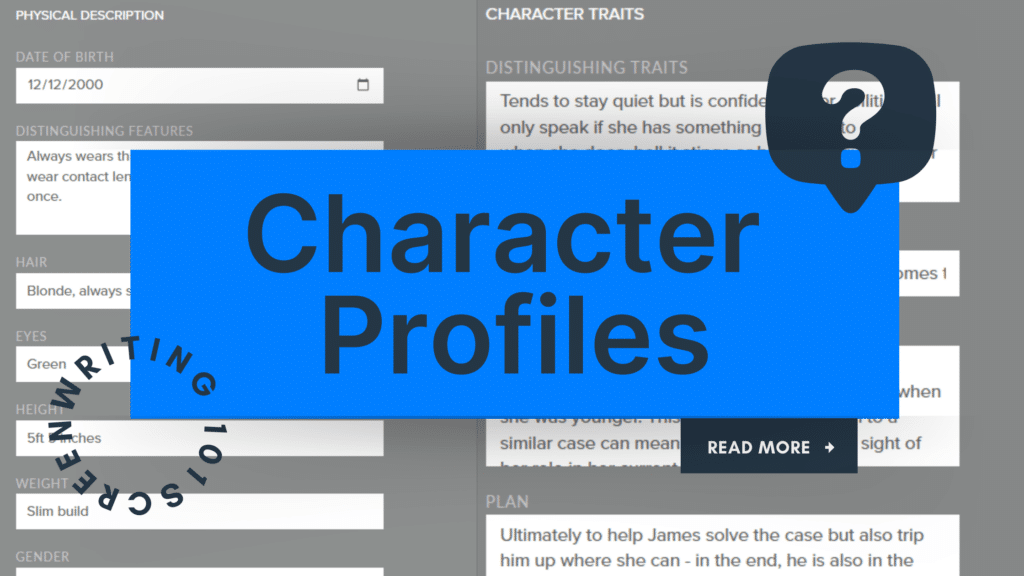
Every story has a lens through which it’s told. Each perspective influences how audiences experience characters, plot, and emotions.
These perspectives are also known as points of view (POV), and one of the most popular and flexible choices among writers of all mediums is third person point of view.
From novels and screenplays to short stories and poetry, third person point of view is crucial for all writers to understand. It allows us to create distance or closeness to characters as well as build a layered and nuanced narrative.
In today’s blog, we’re talking all things third person point of view including its different types, its effectiveness in screenwriting in particular as well as diving into a few well-known examples of third person POV in film and television.
Also look out for our practical tips for writing in third person POV and how Celtx can help along the way.
Let’s get started.
Table of Contents
- What is Third Person POV?
- Types of Third Person POV
- Why it’s Effective in Screenwriting
- Examples of Third Person POV in Film and TV
- Tips for Writing in Third Person
- Tools for Third Person POV
- Conclusion

What is Third Person POV?
Third person point of view tells events from the perspective of the person being discussed. Pronouns such as he, she, it, and they are used to convey this, as well as the name of the subject if applicable.
For example, in a screenplay, the narrator would say:
“John sped down the corridor, his hair bouncing as he ran.”
Notice how the character’s name and the pronouns his and he were used.
In contrast, if we were referring to John in the first person and John was the one narrating, the sentence would change:
“I sped down the corridor, my hair bouncing as I ran.”
Pronouns I and my are used to define the point of view used here.
Third person point of view often distances the reader from the subject, the narrative not including the reader or acknowledging their existence. Whereas first and second point of view may do just that: “I had not intended to love him; the reader knows I had wrought hard to extirpate from my soul the germs of love there detected…” (Brontë in Jane Eyre).
Types of Third Person POV
There are third person POV options to choose from:
Third Person Limited
Third person limited follows one character from beginning to end. We stay consistently with that person, following their insight into the world. They are the ones moving the story forward.
The narrator in this case is omniscient: they know the full story already and what is going to transpire. Your protagonist does not.
Examples of third person limited works include:
- Cloud Atlas – David Mitchell
- A Game of Thrones – George RR Martin (one character per chapter)
- Thanks for the Memories – Cecelia Ahern
This perspective allows you to really develop a character’s psyche, giving your audience an in-depth insight into their personal world, emotions, and reactions to what is happening around them. Your descriptions can also be specific, homing in on what the characters themselves focus on, rather than giving a more general description. You can be specific!
The audience also learns about plot events, twists, and turns simultaneously with the protagonist, so they truly go on the journey with them.
Third person limited also allows you to build effective suspense and interest. Written well, you can draw an audience in, meaning they buy into your protagonist and care about what happens to them.
Of course, the caveat to writing in third person limited is that your audience only sees one point of view. The emotions and journeys of other characters are merely surface level, or there is less opportunity to develop them. Additionally, it can be easier than you think to slip into describing another character’s feelings or divert off into their story. Make sure to stick with your protagonist.
Consider role playing video games, where you take on the role of one character embarking on a quest or journey. As the player, you follow the protagonist’s path, but don’t have the opportunity to see things from other characters you may meet on the way. Games such as The Elder Scrolls V: Skyrim, Dark Souls and Assassin’s Creed Valhalla are such examples.

Third Person Omniscient
We have already discussed that to have an omniscient narrator, they need to know everything that’s happened in the plot. The difference with third person omniscient as a sub-category is that the narrator doesn’t just focus on a single protagonist but instead switches between multiple characters.
This means they can explore the thoughts, feelings, and actions of any character, each to a greater or lesser degree. The narrator can also have any bias and voice their own opinion throughout the plot.
Examples of third person omniscient works include:
- Lord of the Flies – William Golding
- A Wizard of Earthsea – Ursula K Le Guin
The freedom of third person omniscient is clear; the narrator can freely bounce between characters, their perspectives, and different motivations. Writers can create attention-grabbing conflict, building it over a series of chapters.
The narrator can also lean towards any bias, favoring some characters over others, usually the protagonist. This also means they can directly address the reader, unlike in third person limited.
Third person omniscient narrators can also explore context within the characters’ world. Instead of just being stuck to one character, they can build on details invisible to them, by considering the emotions and actions of other characters.
Third Person Objective
This third person narrator is the most neutral and impersonal of them all. Along with the reader, they discover the plot along with the characters, not privy to thoughts and feelings. No perspective is focused upon, with the narrator playing an observational role, meaning the audience is almost eavesdropping on the unfolding events.
Usually implemented within short fiction, the third person objective doesn’t reveal judgments or opinions on behalf of the narrator. It forces the reader to interpret and conclude events in their own way. When done well, you can spark insightful and interesting conversation between readers.
Examples of third person objective include:
- Hills Like White Elephants – Ernest Hemingway
Of course, an advantage of using this point of view is one which we’ve discussed; the ability to keep your audience guessing and drawing their own conclusions from your writing.

But when is it not advisable to use third person POV? While it is a versatile perspective to write from, it’s not always the most effective when:
- You’re trying to convey a deeply personal narrative involving trauma, obsession or memory. First person could offer a more immersive experience in this case.
- You want to use an unreliable narrator and confine your story to one perception or bias.
- You’re writing stories or content that directly addresses the reader. Second person or first-person narration may be better to create a more conversational tone.
Want help organizing your story from any POV?
Try Celtx—your all-in-one script writing software.
Click here to sign up
Why it’s Effective in Screenwriting
We tend to find that mediums such as novels and short stories mostly rely on internal monologue.
On the other hand, screenwriting is a visual medium, which makes third person POV the perfect perspective from which to write a screenplay. Let’s explore the reasons why in more detail:
1. Mirrors the Camera
Screenplays tend to be written in present-tense third person, describing the action as it unfolds without access to a character’s internal thoughts.
This approach mirrors the way the camera ‘sees’ a story, observing from the outside in.

2. Audience Engagement
The third person perspective allows viewers to interpret character motivations through visual cues such as subtext, body language, and dialogue, rather than being told directly. This approach increases audience engagement in the story by encouraging them to read between the lines and figure things out for themselves.
3. Allows for Multiple Character POV
Unlike first person narratives, screenplays often jump between characters. Third person POV gives us screenwriters the flexibility to follow multiple characters in different scenes while keeping the narrative coherent and flowing well.
Examples in Film and TV
Case Study #1 | Harry Potter (2001-2011)
While the original book series is primarily in third person limited (centered around Harry), the films adopt a third person cinematic POV, allowing the audience to occasionally see events that Harry isn’t fully aware of, for example, Voldemort’s plans or actions in the wider wizarding world.

Here’s the scene pictured in Steve Kloves’ adapted screenplay:


Case Study #2 | The Queen’s Gambit (2020)
This hit Netflix series follows Beth Harmon in third person limited. The story depicts Beth’s emotional journey through visual storytelling. Her expressions, body language, and surroundings convey her inner turmoil without the need for an internal monologue. Everything is shown visually and through action.

Check out this excerpt from the pilot episode where we see this visual storytelling in action:


Case Study #3 | The Godfather (1972)
Always a classic and a masterclass in screenwriting, The Godfather uses third person omniscient to show the audience the inner workings of the Corleone family from different angles.
We move smoothly between Michael, Vito and even the Corleone’s enemies. This technique gives the audience a wider understanding of how morally complex the story really is beneath the surface.

In this early scene, where the Corleone family gather for a family photo, we are shown perspectives of all the different family members, telling us something about each one of them and how different they are.

Third person works best when you stay consistent —
our script writing software can help with that.
Click here to get started!
Tips for Writing in Third Person
Here come the all-important tips you need for writing in third person POV. It does require more than just choosing the right pronouns. Here are four ways you can level up your writing:
1. Choose Your Scope Wisely
The first thing you’ll want to do is decide whether you want to use limited, omniscient, or objective third person. Then stick to it! The last thing you want to be doing is changing it halfway through your story and confusing your audience.
2. Use Specific Language
With third person POV, you can’t rely on a character’s voice like you would in the first person. Make sure to use precise and vivid language to keep your audience immersed in the action.

3. Show, Don’t Tell
The age-old screenwriting advice rings true when it comes to third person POV. Remember, actions speak louder than words or thoughts. Focus on using physical cues and dialogue to convey emotion to the audience.
4. Avoid Head-Hopping
If you decide to use third person limited, it’s important that you stay with one character per scene to avoid jarring shifts in perspective. If you want to explore multiple characters’ points of view, use clear scene breaks to ensure a smooth transition.
Tools for Third Person POV
If you’re writing a screenplay and aren’t using proper screenwriting software, then what are you doing?
Here at Celtx, our scriptwriting software can streamline your writing process, leaving you to do one thing: be creative and write. How? Well, let us explain:
- Our suite of tools adheres to industry-standard script formats which are usually written using third person POV.
- You can easily keep track of multiple perspectives and scenes with our in-built script planning tools.

- Our beat sheets, storyboards and shot lists complement your script, allowing you to seamlessly switch between them.
- Collaborate easily with other writers, directors and producers to format your scripts and accompanying documents.
Want to learn more? Check out how Celtx can help you with your next third person narrative here.
Conclusion
Third person POV is a powerful narrative tool that offers vast possibilities in screenwriting.
By choosing limited, omniscient, or objective, we can control how much our audiences know, how they interpret events, and how they emotionally connect with our characters.
With the help of tools like Celtx, you can structure your story visually and narratively to bring your third-person vision to life.
Ultimately, the third person point of view is all about balance: between intimacy and distance, revelation and mystery, control and freedom. Master it, and you’ll wield one of storytelling’s most versatile and effective techniques.
Up Next:

Building Better Characters: What is a Character Profile and How to Use it
When it comes to crafting powerful stories, few elements are as crucial as the characters that drive them. This guide will teach you what a character profile is and how to use it to build complete characters.
